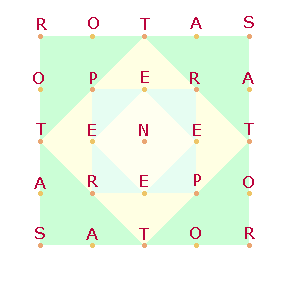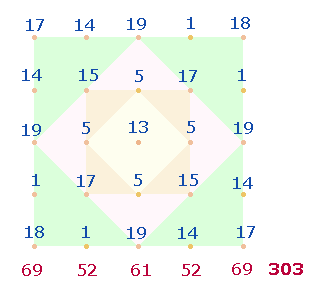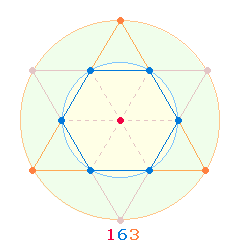Numerical values of
Alphabet
D. Shakespeare's Reference
Models of Gematria in Sonnet 136
B. Initial and Final Letters of Lines (I)
C. Gematric
Values of Whole Sonnet
III. SHAKESPEARE'S HIDDEN EXISTENCE
IV. Synopsis of reference models
I. SATOR Square
1.
So far I have tried to relate
numbers to names. But is seems that Shakespeare knew a lot about the meanings
of numbers. Two central numbers are 11
and 13. As has
been shown in the first part, a group of 5 lines around line 6 consists of 50 words, the remaining 3+6 lines of 25+50
words. So it's reasonable to add up the gematric values of the 9 lines as well. It's 3601 = 277*13.
|
1 |
2 |
3 |
4 |
5 |
6 |
7 |
8 |
9 |
10 |
11 |
12 |
13 |
14 |
sm |
|
366 |
455 |
423 |
498 |
432 |
375 |
420 |
287 |
358 |
429 |
363 |
391 |
418 |
410 |
5625 |
2.
It's well-known that
Shakespeare's favourite Latin poet was OVID, whose Metamorphoses he highly appreciated. The
creation of man (1,76-88)
consists of 13 lines, 85 words, and 480 letters, just as sonnet 136. The total gematric value of the 13 lines is also a square number: 73*73.
|
2 |
3 |
4 |
5 |
6 |
7 |
8 |
9 |
10 |
11 |
12 |
13 |
sm |
|
|
407 |
405 |
430 |
391 |
426 |
303 |
462 |
406 |
411 |
368 |
447 |
461 |
412 |
5329 |
3.
Line 6, which is so important in the sonnet, has the
gematric value 303,
which is the total value of the SATOR SQUARE:
|
|
|
Shakespeare must have known this square and also the nature
of the TETRAKTYS STAR:
|
|
This graph shows how a tetraktys is constructed: 1 central point, 6 hexagonal points on the arc of the circle and 3 points on the outer circle. A reference to this
construction may be seen in the number of the sonnet 136 and in the gematric value 163 of the initials of the 14 lines.
One tetraktys constists of 37 elements, 10 points, 18
lines and 9 equilateral
triangles, points and triangles representing a unity of 19 against the number of lines. So the name WILLIAM with its gematric value 74 can be related to the elements of two tetraktys.
4.
The number 11 is not a prime factor in the 3 numeric sums of the SATOR-Square: 69 = 3*23, 52
= 4*13 and prime number 61. But it becomes important in composite results:
69+52 = 121 = 11*11;
52+61+52 = 165 =
15*11.
The second addition marks an inversion from one half to the
next. The first can be repeated for the second half of the magic square so that
the three sums total (11+15+11)
= 37*11 = 407,
which is the first numeric value (NV)
of the 13 Ovid lines and in double size 814 by the symmetrical addition of lines 3+12 (423+391)
in the sonnet.
The prime factor 13
appears again in the addition 69+61 = 130 = 10*13. So the three words SATOR OPERA TENET – The creator holds his works has the
total NV 182 = 13*14.
5.
The four prime factors of the
SATOR-Square 23+61 = 84; 11+13 = 24,
totalling 108
= 9*12, are
contained in 6 NV of the 14
sonnet lines. Three of them are divisible by 11: 363+429+418 = 1210, indicating ten times
the sum of 69+52 = 121. The
other three numbers are 366+455+391 =
1212.
The two sums form a symmetry around the number 1211. 1212
= 4*303 reflects the NV of the SATOR Square.
II. FACTORAL VALUES
1.
The study of numeric values (NV) so far have shown that Shakespeare included in his
calculations the factors
of numbers. The added prime factors of a number can be called its factoral value (FV). Factoral values furnish further meanings in
gematrical practice. Numerical and factoral values can be related to each
other, which leads by a calculating process to interpretable results.
In the present context I confine myself to the sum of 1210+1212 = 2422. The factors are 2*7*173, which add up to 182,
the gematric value of SATOR OPERA TENET.
2.
If FV are applied to the four names, many new combinations
of numbers become possible. Of course, the question is how far Shakespeare
included them into his calculations. Beside the NV he could add 3 new categories. For this purpose it is necessary
to specify the term Numerical Value: It means exactly "the Sum of Numerical
letter values". Besides also the Sum
of Factoral values
can be determined. For the sake of distinction the abbreviations NS and FS
are now used. The factoral values of NS
and FS are abbreviated as FV1 and FV2.
3.
The four values of the four
names look like this:
|
|
NS |
FS |
|
FV1 |
FV2 |
|
|
|
WILLIAM |
74 |
52 |
126 |
39 |
17 |
56 |
182 |
|
WILL |
52 |
38 |
90 |
17 |
21 |
38 |
128 |
|
|
126 |
90 |
216 |
56 |
38 |
94 |
310 |
|
AEMILIA |
48 |
37 |
85 |
11 |
37 |
48 |
133 |
|
EMILIA |
47 |
36 |
83 |
47 |
10 |
57 |
140 |
|
|
95 |
73 |
168 |
58 |
47 |
106 |
273 |
|
|
221 |
163 |
384 |
114 |
85 |
199 |
583 |
The
four values 182 of WILLIAM
correspond to the NV of SATOR OPERA TENET. The short form WILL
has the NS of the FS of WILLIAM.
The
four values of WILLIAM and EMILIA
form the ratio 182:140 = 14*(13:10) = 24*13.
The totals 310
and 273
contain important inverse numbers: 10*31 / 21*13.
The
NS and FS of WILL and AEMILIA
form the ratio 100:75 = 25*(4:3).
III. SHAKESPEARE'S HIDDEN EXISTENCE
1.
To assume that Shakespeare
practised some gematria now and then, wouldn't surprise anyone at all. To
associate him with the SATOR-Square as a central model and motive for gematria,
would appear somewhat more surprising. But to claim that every letter of
classical Latin poetry was counted and given a numerical value according to the
order of the alphabet, that Shakespeare did not only acquire a stupendous
knowledge of numerology but was able to employ Roman gematria as perfectly as
the classical poets Vergil, Horace and Ovid, seems to be beyond sound reason.
On the other and, so many phantastic things have been said
on the poet that, paradoxically, my credibility needs would suffer damage if I
didn't contribute another phantastic theory.
My theory can't do without two premises: First, the
superlatives about Shakespeare's intelligence in general and his poetic genius
in particular must not be called into question or diminished. Second, the
rumours that he was a secret Papist who
stayed on the Continent and even in Italy must not be discredited. In fact, the
German professor Hildegard Hammerschmidt-Hummel produced a number of plausible
arguments to support this premise.
2.
So, in pursuing Shakespeare's
acquaintance with gematria, we mustn't set up any impediments to our
imagination. His school education, right from the beginning, imbued him with
all the hardships and blessings of Latin. He became familiar with original
Latin prose and poetry. A bright mind that he was, he will, at some point of
time, have wondered how there could be the most bitter conflicts between
Christians, while classical literature, though written by pagans, was
considered the indispensable foundation of perfect education.
3.
We may suppose that he, perhaps
still in his teens, met with the famous SATOR-Square which exercised greatest
influence on his frame of mind. He furthermore may have received the idea from
somewhere to convert letters into numbers according to their alphabetical order
and applied it to the SATOR-Square.
At the next stage he studied Latin texts, counting the
numeric values of verses. He may have wondered, for example, at the value 1553 for the first four lines of the metamorphoses,
showing him that Ovid in this way indicated the 15 books of his epic work as a full number and by the
factors 3 times 5.
In studying Ovidian texts meticulously, Shakespeare
learned
Let's also suppose that Shakespeare learned about the
Pythagorean tetraktys and how it was constructed as a geometrical figure.
Still, there lay some work of reflexion before him, till
he fully understood the Roman system of numbers.
4.
What Shakespeare at last
understood, was this: God gave his spirit to all peoples and nations, before
even Christ was born. The SATOR-Square showed that there was a belief in one
God in a kind of trinitarian nature though Rome's public cults suggested the
existence of numerous gods and goddesses. The idea of one God was inscribed and
inherent in the structure of numbers. He surmised that the poets themselves did
not confess their religious convictions openly, but elaborated them by numeric
constructions. Perhaps he understood that the strength of a civilisation could
consist in keeping divine wisdom secret.
In studying Ovidian and other texts meticulously,
Shakespeare learned that the quality of classical poetry consisted in the
employment of rational principles of form and structure, which secured it
timeless validity. As an English patriot and ambitious poet he wanted to be for
his nation what the Roman poets did for their Empire.
5.
Ovid could teach Shakespeare
that God was not far away but was present in all the wonderful details of his
creation. The God of his poetry was an implied God expressing himself in the
richness and variation of his creation.So he decided to serve a universal God
of all times and all peoples in the wisdom of numbers without defecting from
Christianity. And we can imagine that as universal as his poetic principles
were his religious beliefs which he may have seen more originally represented
in the Catholic Church of Rome than in the Anglican.
Shakespeare
was not unaware that perfect poetry could be written without gematria. But
gematria was an essential addition of divine wisdom which the poet shared with
God only. He understood what is the experience of many people that there are
secrets that can't be shared with another human being.
Shakespeare
experienced that he was rewarded for his infinite efforts of working out
numeric constructions by receiving a freedom of mind that raised him above all
his contemporaries. He was given the freedom to explore the depths of sexuality
as a main field of human relations.
6.
In employing the concept of
gematria, Shakespeare met with one difficulty that did not exist in Latin: the
inconsistency of pronunciation and spelling. He obviously accepted this
cultural fact and so made the English language, both sound and letter, a
rational equivalent of Roman literature.
7.
Once he had comprehended the
divine nature of numbers and God's plan to make the Latin language a perfect
vessel to understand them, he could relate Latin terms to Christian words and
names, and also to English words. Thus 105 is the numeric value both for NUMERUS and TRINITAS, and NUMBER has the same value 69 as SATOR.
Finally, the name IESUS (70) CHRISTUS (112)
has the same gematric value as SATOR OPERA TENET,
which enabled Shakespeare to serve Christ under the chiffre of a numerological system.
The
transition from Latin to English alphabet was rather easy for Shakespeare and
other people who wanted to employ gematria. They had just to insert W after V/U,
because I/J and V/U were used for the same sounds.
The
letter X as 21st letter could be rendered by A+V so that the central word WE might read AVE, taking on a religious meaning in Shakespeare's
mind perhaps in reference to Holy Mary.
Written: December 2008


